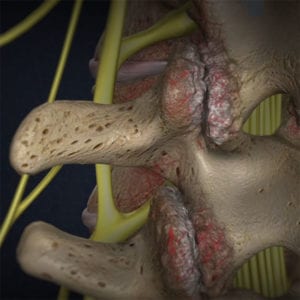Disc degeneration is a condition that develops in areas of frequent movement in the lumbar spine. The lumbar portion of the spinal column, or the lower back, is especially prone to disc degeneration, as it can be subject to excessive stress and movement. The desiccation or dehydration of the disc can reduce the size and flexibility of the disc, causing pain and nerve pressure. Although many patients experience some form of disc degeneration later in life, patients suffering from lumbar degenerative disc disease may experience discomfort earlier in life due to an accelerated rate of disc degeneration.
 When the discs of the lumbar spine degenerate, pressure is placed on delicate nerves in the spine, causing discomfort. Patients suffering from lumbar degenerative disc disease may experience a variety of symptoms, including pain, burning, reduced movement, or tingling. Pain or tingling can even travel to the extremities, through branching nerves connected to the site of the degenerative disc. When left untreated, the spinal column can become unstable, causing the spine to develop bone spurs. These spurs can worsen the symptoms of lumbar degenerative disc disease.
When the discs of the lumbar spine degenerate, pressure is placed on delicate nerves in the spine, causing discomfort. Patients suffering from lumbar degenerative disc disease may experience a variety of symptoms, including pain, burning, reduced movement, or tingling. Pain or tingling can even travel to the extremities, through branching nerves connected to the site of the degenerative disc. When left untreated, the spinal column can become unstable, causing the spine to develop bone spurs. These spurs can worsen the symptoms of lumbar degenerative disc disease.
Diagnostic imaging can be a key tool in the diagnosis of lumbar degenerative disc disease. X-ray, MRI, or discography/CT scans can help a doctor diagnose disc degeneration in a patient. Nerve blocks or epidurals may be used to help determine pain levels associated with the lumbar disc. Once diagnosed, a pain management doctor can develop a treatment plan that suits the patient’s needs.
